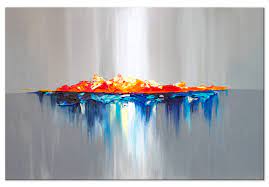Exploring the Beauty of Modern Abstract Art: A Contemporary Perspective
The Evolution of Modern Abstract Art
Modern abstract art has revolutionised the way we perceive and interpret artistic expression. Characterised by its departure from traditional forms and representations, abstract art challenges viewers to explore the depths of their imagination and emotions.
Emerging in the early 20th century, artists such as Wassily Kandinsky, Piet Mondrian, and Kazimir Malevich paved the way for the abstract movement. They sought to move beyond the constraints of realism and create art that spoke directly to the soul.
One of the defining features of modern abstract art is its emphasis on form, colour, and line over representational content. Artists experiment with shapes, textures, and compositions to evoke a range of emotions and interpretations in the viewer.
Abstract expressionism, a significant development within modern abstract art, emerged in post-World War II America. Artists like Jackson Pollock and Willem de Kooning embraced spontaneity and gestural brushwork to convey raw emotion and energy on canvas.
As modern abstract art continues to evolve, contemporary artists push boundaries even further by incorporating new technologies, materials, and concepts into their work. From large-scale installations to digital creations, abstract art remains a vibrant and dynamic force in the art world today.
Whether you are drawn to bold geometric shapes or swirling layers of colour, modern abstract art offers something for every viewer to appreciate and interpret in their own unique way.
Exploring Modern Abstract Art: Key Questions and Insights
- What is modern abstract art?
- Who are some famous modern abstract artists?
- How did modern abstract art develop?
- What are the key characteristics of modern abstract art?
- How can one interpret or understand modern abstract art?
- What role does technology play in contemporary abstract art?
What is modern abstract art?
Modern abstract art is a genre of artistic expression that emerged in the early 20th century, challenging traditional forms of representation by prioritising form, colour, and line over realistic depictions. Artists within this movement seek to evoke emotions and interpretations through non-representational means, encouraging viewers to engage with the artwork on a more visceral and imaginative level. Characterised by its departure from realism, modern abstract art encompasses a wide range of styles and techniques, from geometric shapes and bold colours to gestural brushwork and textured surfaces. This genre continues to evolve and inspire contemporary artists to push boundaries and explore new ways of self-expression beyond the confines of traditional artistic conventions.
Who are some famous modern abstract artists?
When exploring the realm of modern abstract art, one cannot overlook the contributions of several renowned artists who have left a lasting impact on the art world. Some of the most famous modern abstract artists include Wassily Kandinsky, known for his pioneering use of colour and form to convey spiritual themes; Piet Mondrian, celebrated for his iconic geometric compositions that epitomise neoplasticism; and Jackson Pollock, whose innovative drip painting technique defined the abstract expressionist movement. These artists, among others like Mark Rothko, Joan Miró, and Yayoi Kusama, have each made significant strides in shaping the landscape of modern abstract art with their distinctive styles and visionary approaches.
How did modern abstract art develop?
Modern abstract art developed as a response to the changing cultural and societal landscape of the early 20th century. Artists sought to break away from traditional forms of representation and explore new ways of expressing themselves. Influenced by movements such as Cubism, Futurism, and Dadaism, pioneers like Wassily Kandinsky and Piet Mondrian began experimenting with shapes, colours, and lines to convey emotions and ideas in a more abstract manner. This shift towards non-representational art marked a significant departure from the conventions of the past and laid the foundation for the diverse and dynamic world of modern abstract art that we see today.
What are the key characteristics of modern abstract art?
Modern abstract art is characterised by a departure from representational forms and a focus on non-representational elements such as form, colour, and line. Key characteristics of modern abstract art include the use of geometric shapes, bold colours, and dynamic compositions to evoke emotional responses and stimulate the imagination of the viewer. Artists often explore concepts of spontaneity, experimentation, and abstraction in their work, pushing the boundaries of traditional artistic conventions to create innovative and thought-provoking pieces that invite interpretation and introspection.
How can one interpret or understand modern abstract art?
Interpreting and understanding modern abstract art can be a deeply personal and subjective experience. Unlike representational art, abstract art often does not have a clear narrative or easily identifiable subject matter. Instead, viewers are encouraged to engage with the artwork on an emotional and intuitive level. One approach to interpreting abstract art is to focus on the formal elements such as colour, shape, line, and texture. Paying attention to how these elements interact and create visual harmony or tension can offer insights into the artist’s intentions. Additionally, allowing oneself to be open to multiple interpretations and embracing ambiguity can lead to a richer and more fulfilling understanding of modern abstract art. Ultimately, there is no right or wrong way to interpret abstract art – it is about exploring one’s own responses and connections with the artwork.
What role does technology play in contemporary abstract art?
Technology plays a pivotal role in shaping contemporary abstract art, offering artists innovative tools and mediums to explore new horizons of creativity. From digital software that enables the creation of intricate patterns and designs to interactive installations that engage viewers in immersive experiences, technology has expanded the possibilities for artists to experiment and push boundaries in their abstract works. Artists harness the power of technology to manipulate light, sound, and space, creating dynamic artworks that challenge traditional notions of art and invite audiences to engage with art in novel ways. The fusion of technology and abstract art continues to inspire fresh perspectives and redefine the boundaries of artistic expression in the modern world.


